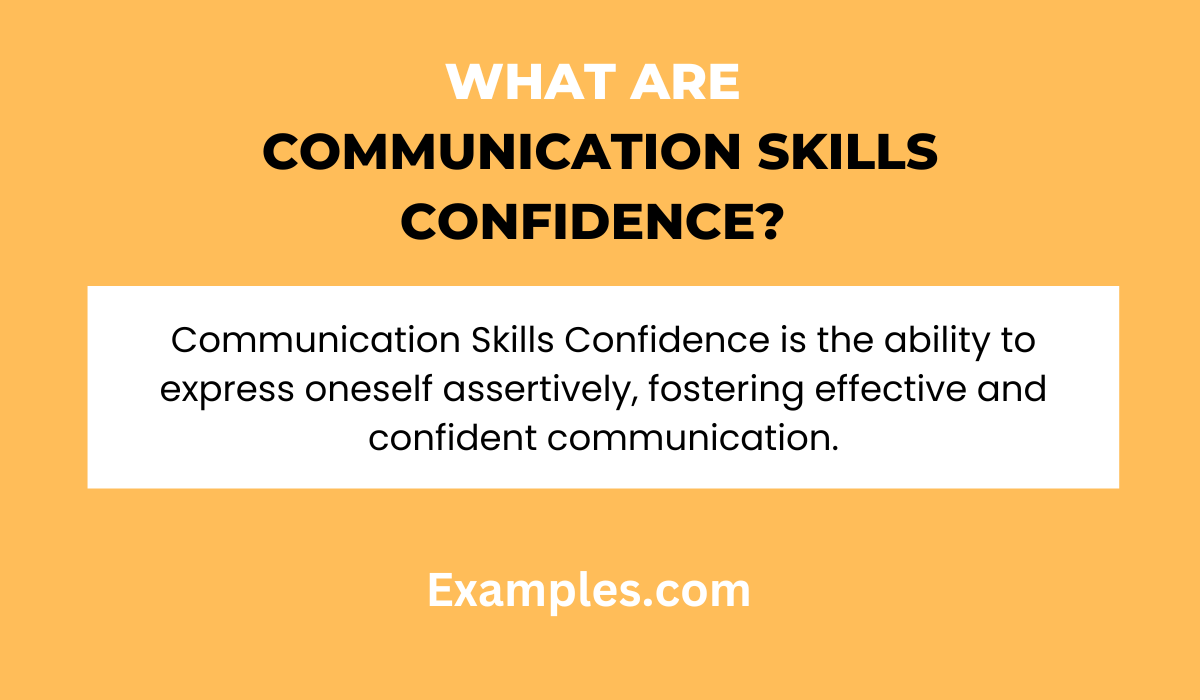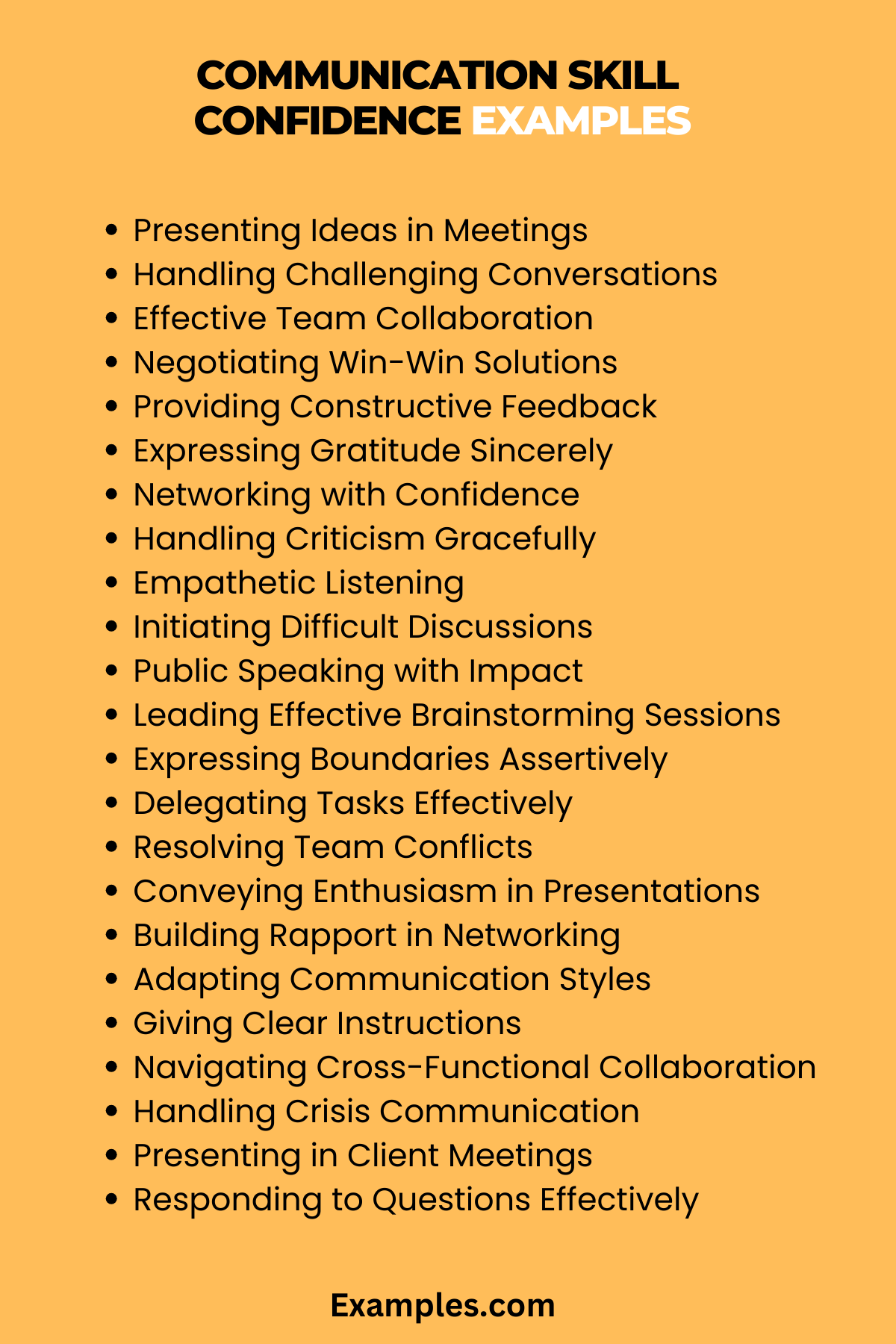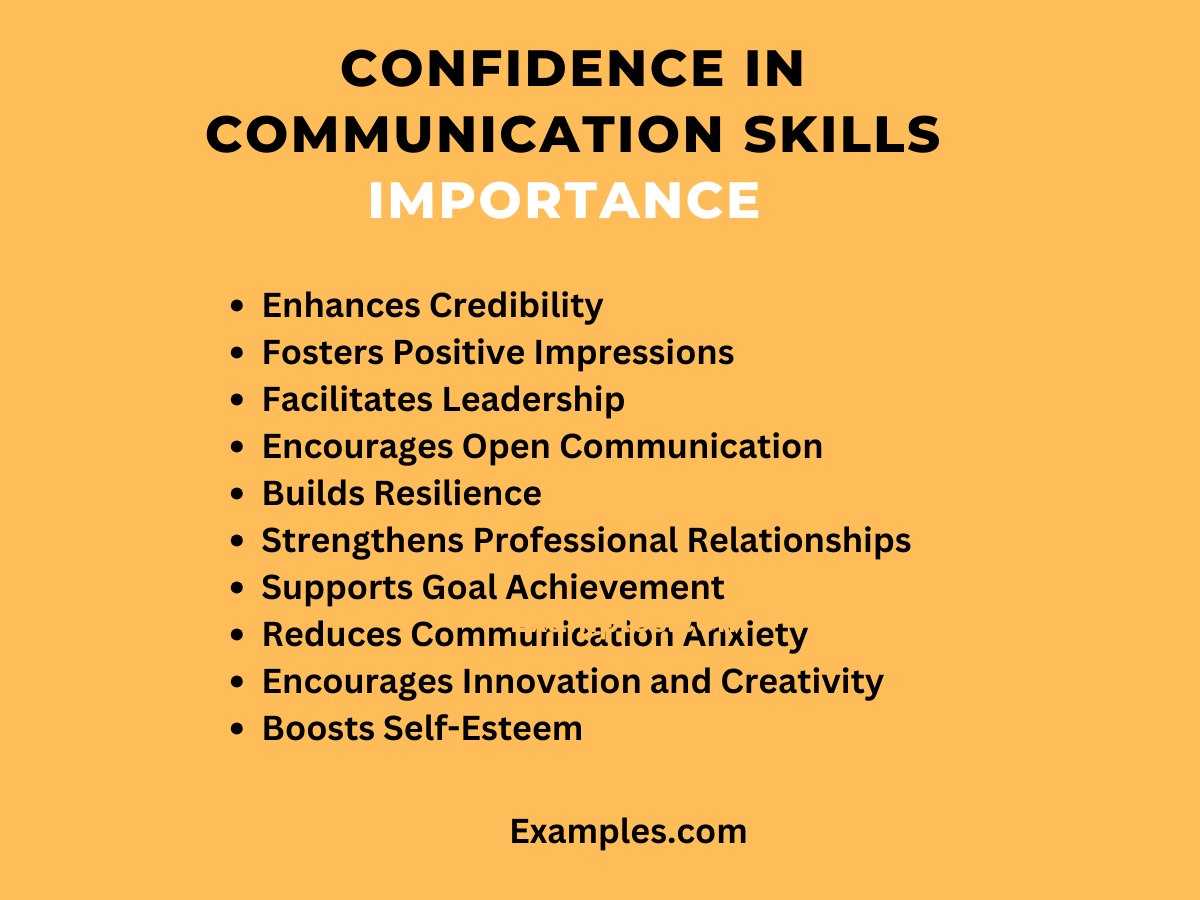29+ Communication Skills Confidence Examples
Embark on a transformative journey of mastering communication skills with unwavering confidence. This comprehensive guide navigates through real-world scenarios, offering practical examples that illuminate the seamless fusion of effective communication and self-assurance. Uncover the power of confident communication through vivid instances and gain valuable insights to elevate your interpersonal interactions in various spheres.
What are Communication Skills Confidence?
Communication skills confidence encapsulates the synergy between adept communication abilities and unwavering self-assurance. In essence, it goes beyond mastering verbal and nonverbal communication, embodying the belief in one’s capacity to express ideas assertively and connect authentically with others. This confidence is foundational for impactful interactions in both personal and professional realms.

30 Communication Skills Confidence Examples
Empower your communication with confidence through these exemplary instances. From assertive workplace conversations to navigating personal relationships, these examples showcase the seamless integration of communication skills and self-assurance. Explore real-world scenarios that illustrate the art of confident communication, providing inspiration and practical guidance for mastering this essential skill.

- Presenting Ideas in Meetings:
Example: “Boldly presenting innovative proposals, fostering engagement and enthusiasm among team members.” - Handling Challenging Conversations:
Example: “Approaching difficult discussions with tact, expressing opinions with clarity while maintaining composure.” - Effective Team Collaboration:
Example: “Leading collaborative efforts with confidence, ensuring open communication and a cohesive team dynamic.” - Negotiating Win-Win Solutions:
Example: “Negotiating with assertiveness, seeking mutually beneficial outcomes for all parties involved.” - Providing Constructive Feedback:
Example: “Delivering feedback with confidence, emphasizing strengths and suggesting improvements diplomatically.” - Expressing Gratitude Sincerely:
Example: “Expressing gratitude authentically, making others feel valued and appreciated.” - Networking with Confidence:
Example: “Approaching networking events with self-assurance, initiating conversations and building meaningful connections.” - Handling Criticism Gracefully:
Example: “Responding to criticism confidently, using feedback as an opportunity for growth and improvement.” - Empathetic Listening:
Example: “Listening attentively, responding with empathy, and creating a supportive communication environment.” - Initiating Difficult Discussions:
Example: “Approaching sensitive topics with confidence, fostering open dialogue for resolution and understanding.” - Public Speaking with Impact:
Example: “Commanding the stage with confidence, delivering impactful speeches that captivate and inspire.” - Leading Effective Brainstorming Sessions:
Example: “Guiding brainstorming sessions assertively, encouraging diverse ideas and collaborative problem-solving.” - Expressing Boundaries Assertively:
Example: “Communicating personal boundaries confidently, ensuring respect while maintaining a positive relationship.” - Delegating Tasks Effectively:
Example: “Delegating responsibilities with clarity and confidence, ensuring efficient task distribution within a team.” - Resolving Team Conflicts:
Example: “Mediating conflicts with confidence, fostering understanding and collaboration for a harmonious team environment.” - Conveying Enthusiasm in Presentations:
Example: “Injecting enthusiasm into presentations, captivating audiences with a confident and engaging delivery.” - Building Rapport in Networking:
Example: “Building rapport effortlessly in networking, connecting with authenticity and leaving a lasting impression.” - Adapting Communication Styles:
Example: “Adapting communication styles confidently, tailoring interactions to suit diverse personalities and preferences.” - Expressing Ideas in Group Discussions:
Example: “Contributing ideas in group discussions with confidence, promoting constructive dialogue and collaborative problem-solving.” - Giving Clear Instructions:
Example: “Providing clear instructions assertively, ensuring understanding and effective task execution.” - Celebrating Team Achievements:
Example: “Celebrating team achievements with confidence, acknowledging contributions and fostering a positive team spirit.” - Navigating Cross-Functional Collaboration:
Example: “Leading cross-functional collaborations with confidence, bridging gaps and ensuring seamless communication.” - Handling Crisis Communication:
Example: “Addressing crises confidently, communicating transparently and reassuring stakeholders with a composed demeanor.” - Empowering Team Members:
Example: “Empowering team members with confidence, recognizing individual strengths and fostering a sense of collective achievement.” - Presenting in Client Meetings:
Example: “Presenting ideas in client meetings confidently, establishing credibility and building client trust.” - Responding to Questions Effectively:
Example: “Answering questions with confidence, providing clear and concise responses that demonstrate expertise.” - Motivating Team during Challenges:
Example: “Motivating the team during challenges, instilling confidence and maintaining a positive outlook.” - Building Effective Work Relationships:
Example: “Building work relationships confidently, establishing trust and rapport with colleagues at all levels.” - Facilitating Productive Workshops:
Example: “Facilitating workshops with confidence, guiding participants through interactive sessions for optimal learning.” - Creating a Positive Work Atmosphere:
Example: “Cultivating a positive work atmosphere with confidence, inspiring camaraderie and mutual respect among team members.”
Communication Skills Confidence Examples for Students
Empower students with robust communication skills and unwavering confidence. These examples illustrate how cultivating self-assurance enhances interactions in academic and social settings. Explore instances tailored for students, promoting effective communication that fosters a positive learning environment.
- Participating Actively in Class: Boldly contributing ideas during class discussions, encouraging a vibrant exchange of thoughts among peers.
- Expressing Thoughts in Presentations: Confidently delivering presentations, showcasing subject knowledge and communication prowess to classmates.
- Engaging in Group Projects: Collaborating with peers confidently on group projects, ensuring effective communication and shared success.
- Asking Questions in Clarification: Fearlessly asking questions for clarification, demonstrating a proactive approach to understanding academic concepts.
- Participating in Extracurricular Activities: Confidently engaging in extracurricular activities, developing communication skills while contributing to school community initiatives.
- Seeking Teacher’s Guidance: Approaching teachers with confidence to seek guidance, fostering open communication for academic growth.
- Facilitating Peer Learning: Leading peer learning sessions with confidence, facilitating knowledge sharing and collaborative understanding.
- Presenting Creative Projects: Boldly presenting creative projects, expressing ideas with flair and confidence to captivate classmates.
- Navigating Social Situations: Confidently navigating social situations, communicating with peers to build positive relationships within the school community.
- Participating in Debates: Taking part in debates with confidence, articulating opinions persuasively and honing critical communication skills.
Communication Skills Confidence Examples in the Workplace
Elevate your professional interactions with confidence. Learn how to assertively lead meetings, navigate workplace conflicts, and motivate your team. Explore real-world examples showcasing the seamless integration of communication skills and unwavering confidence. Master the art of expressing ideas persuasively, providing constructive feedback, and handling challenging conversations with tact. Embrace confidence in workplace communication to foster a positive and collaborative work environment.
- Leading Effective Team Meetings: Boldly leading team meetings, fostering engagement, and ensuring clear communication of project goals and expectations.
- Navigating Workplace Conflicts: Handling conflicts assertively, mediating disputes, and guiding the team towards resolutions that benefit all parties.
- Motivating Team Members: Motivating the team with confidence, acknowledging achievements, and fostering a positive and productive work atmosphere.
- Providing Constructive Criticism: Offering constructive criticism confidently, emphasizing areas for improvement while recognizing and reinforcing strengths.
- Presenting Proposals with Conviction: Presenting proposals with conviction, articulating ideas persuasively, and instilling confidence in project stakeholders.
- Expressing Expectations Clearly: Communicating expectations with clarity, ensuring team members understand roles and responsibilities confidently.
- Facilitating Team Brainstorming: Guiding team brainstorming sessions assertively, encouraging diverse ideas and collaborative problem-solving.
- Handling Leadership Challenges: Facing leadership challenges with confidence, making decisions decisively, and navigating uncertainties with composure.
- Negotiating Win-Win Solutions: Negotiating confidently, seeking solutions that benefit all parties involved and fostering positive ongoing relationships.
- Celebrating Team Achievements: Celebrating team achievements with confidence, recognizing individual contributions and fostering a sense of collective success.
Communication Skills Confidence Examples in Relationship
Navigate relationships with assurance, whether personal or professional. Explore examples that showcase effective communication skills, empathy, and assertiveness. Learn to express needs confidently, handle conflicts diplomatically, and build lasting connections through genuine and transparent communication. Master the art of listening attentively, providing emotional support, and expressing gratitude authentically to strengthen your relationships.
- Expressing Emotional Support: Providing emotional support confidently, actively listening, and offering empathy during challenging times.
- Navigating Relationship Conflicts: Handling relationship conflicts assertively, addressing concerns openly, and collaboratively working towards resolutions.
- Building Trust Through Transparency: Building trust confidently through transparent communication, fostering openness and honesty in the relationship.
- Expressing Needs Assertively: Expressing personal needs confidently, ensuring open communication and mutual understanding in the relationship.
- Fostering Open Communication: Fostering open communication with a partner, encouraging sharing and creating a safe space for honest dialogue.
- Listening Actively to a Partner: Listening actively to a partner’s concerns, demonstrating empathy, and validating feelings through responsive communication.
- Handling Relationship Milestones: Navigating relationship milestones with confidence, communicating expectations, and celebrating shared achievements together.
- Expressing Gratitude Sincerely: Expressing gratitude authentically, making the partner feel valued and appreciated for their contributions to the relationship.
- Navigating Family Dynamics: Navigating family dynamics confidently, addressing challenges, and maintaining clear communication for a harmonious relationship.
- Creating Quality Time Together: Creating quality time together with confidence, planning activities, and fostering a strong connection through intentional communication.
How to Master Communication Skills and Confidence?
Mastering communication skills and confidence is a transformative journey that empowers individuals in both personal and professional spheres. Follow these comprehensive steps to enhance your ability to communicate with assurance and poise.
- Understand Your Communication Style: Recognize your natural communication style, whether assertive, passive, or somewhere in between. Understand your strengths and areas for improvement.
- Practice Active Listening: Hone your listening skills by paying close attention to verbal and nonverbal cues. Practice empathy and engage fully in conversations.
- Build a Strong Vocabulary: Expand your vocabulary to articulate thoughts effectively. Use varied and precise language to convey your ideas with confidence.
- Observe Confident Communicators: Identify individuals known for their confident communication. Observe their body language, tone, and choice of words. Learn from their examples.
- Participate in Public Speaking: Engage in public speaking opportunities, whether through presentations, workshops, or group discussions. Overcoming the fear of public speaking builds confidence.
- Seek Constructive Feedback: Request feedback on your communication style from trusted colleagues or mentors. Use constructive criticism as a tool for improvement.
- Embrace Nonverbal Communication: Understand the impact of nonverbal cues such as body language, facial expressions, and gestures. Align your nonverbal communication with your spoken words.
- Visualize Successful Interactions: Practice visualization techniques to picture successful communication scenarios. Envision yourself expressing ideas confidently and receiving positive responses.
- Develop Assertiveness Skills: Cultivate assertiveness by expressing your thoughts and opinions clearly while respecting others. Strike a balance between being firm and maintaining empathy.
- Join Communication Skills Workshops: Enroll in workshops focused on communication skills and confidence-building. Interactive sessions provide practical tips and opportunities for hands-on learning.
Why Confidence is Important in Communication Skills?
Confidence plays a pivotal role in effective communication, influencing how messages are perceived and received. Understanding the significance of confidence in communication skills is crucial for personal and professional growth.

- Enhances Credibility: Confidence reinforces your credibility. When you speak with assurance, others are more likely to trust and believe in the information you convey.
- Fosters Positive Impressions: Confident communicators make positive impressions. Whether in job interviews, meetings, or social interactions, confidence contributes to a favorable image.
- Facilitates Leadership: Leaders exude confidence. Effective leadership requires the ability to communicate decisively, inspire others, and navigate challenges with assurance.
- Encourages Open Communication: Confidence creates an environment conducive to open communication. People are more likely to share their thoughts and ideas when they feel the speaker is confident and approachable.
- Builds Resilience: Confident individuals bounce back from communication challenges more easily. They adapt to unexpected situations, handle criticism constructively, and maintain composure.
- Strengthens Professional Relationships: Confidence fosters stronger professional relationships. Colleagues and superiors are drawn to individuals who communicate with self-assurance, leading to collaborative and productive partnerships.
- Supports Goal Achievement: Confident communication is linked to goal achievement. Whether presenting proposals, leading teams, or negotiating, confidence contributes to successful outcomes.
- Reduces Communication Anxiety: Confidence alleviates communication anxiety. As individuals become more confident, they are better equipped to handle nerves, uncertainties, and the fear of judgment.
- Encourages Innovation and Creativity: Confident communicators are more likely to express innovative ideas and think creatively. Confidence encourages individuals to share unconventional thoughts without fear of rejection.
- Boosts Self-Esteem: Confidence in communication positively impacts self-esteem. As individuals experience successful interactions, they develop a positive self-image, reinforcing a cycle of confidence and accomplishment.
How do you Build Confidence in Communication Skills?
Building confidence in communication skills is a gradual process that involves self-awareness, practice, and a commitment to improvement. Follow these key steps to cultivate confidence in your communication abilities:
- Self-Reflection: Begin by reflecting on your strengths and areas for improvement. Understand your communication style and identify aspects you wish to enhance.
- Set Realistic Goals: Establish achievable communication goals. Break down larger objectives into smaller, manageable tasks to build confidence gradually.
- Learn and Adapt: Stay open to learning. Seek feedback from peers, mentors, or communication experts, and be willing to adapt based on constructive criticism.
- Practice Regularly: Practice is essential for improvement. Engage in conversations, presentations, or role-playing scenarios to refine your skills and build confidence.
- Visualization Techniques: Utilize visualization techniques to imagine successful communication scenarios. Envision yourself expressing ideas clearly and confidently.
- Positive Affirmations: Incorporate positive affirmations into your routine. Remind yourself of past successes and affirm your ability to communicate effectively.
- Join Communication Workshops: Attend workshops or seminars focused on communication skills. Engaging with professionals and peers can provide valuable insights and boost confidence.
- Expand Your Comfort Zone: Challenge yourself by stepping out of your comfort zone. Take on speaking opportunities, initiate discussions, and gradually expand your communication comfort zone.
- Body Language Awareness: Pay attention to your body language. Maintain good posture, make eye contact, and use gestures to convey confidence, reinforcing your verbal communication.
- Celebrate Small Wins: Acknowledge and celebrate small victories. Recognize improvements in your communication skills, reinforcing your confidence-building efforts.
Tips for Effective Communication Skills Confidences
Mastering effective communication skills with confidence involves honing various aspects of your verbal and nonverbal communication. Follow these tips to enhance your communication prowess:
- Clarity is Key: Ensure your messages are clear, concise, and easily understood. Eliminate unnecessary jargon and strive for simplicity in your communication.
- Active Listening: Practice active listening by giving your full attention to the speaker. Respond appropriately, ask clarifying questions, and show genuine interest in the conversation.
- Confident Tone of Voice: Develop a confident tone of voice. Speak clearly, vary your pitch, and use a moderate pace to convey assurance in your communication.
- Maintain Eye Contact: Establish and maintain eye contact during conversations. It fosters a connection, projects confidence, and signals active engagement.
- Embrace Nonverbal Communication: Leverage nonverbal cues such as facial expressions, gestures, and body language to complement your verbal communication, enhancing overall effectiveness.
- Adapt to Your Audience: Tailor your communication style to suit your audience. Consider their preferences, knowledge, and expectations to ensure your message resonates effectively.
- Handle Criticism Constructively: Embrace feedback as an opportunity for growth. Learn to handle criticism constructively, adapting your communication style based on valuable insights.
- Express Empathy: Infuse empathy into your communication. Understand others’ perspectives, acknowledge their feelings, and respond with compassion to build positive connections.
- Preparation is Key: Prepare thoroughly for conversations, presentations, or meetings. Confidence grows when you feel well-prepared and knowledgeable about the topic at hand.
- Continuous Improvement: Commit to continuous improvement. Stay informed about communication trends, seek ongoing learning opportunities, and adapt your skills to evolving contexts.
In conclusion, mastering communication skills with confidence is a transformative journey. By understanding the nuances of effective communication and implementing practical examples, individuals can elevate their interpersonal interactions. This complete guide empowers readers to build confidence systematically, navigate various scenarios with poise, and ultimately foster meaningful connections through the art of articulate and assured communication.



